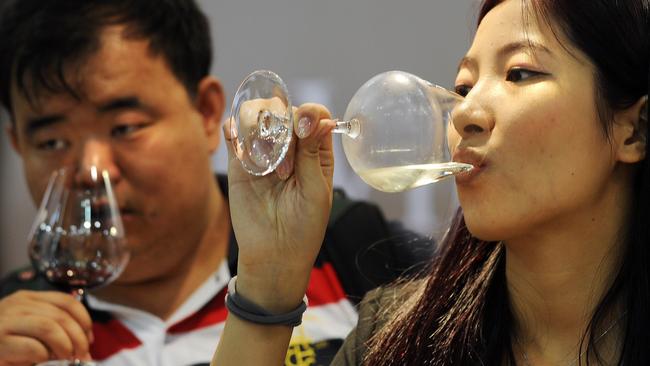Wine exports plunge on Chinese ban, while US growth strategy falls flat
Australia’s wine exports are being battered by Chinese tariffs and shipping chaos, while a US growth strategy is yet to bear fruit, new figures show.

Australian wine exports plunged by more than a quarter in the year to the end of March as Chinese tariffs, global shipping chaos and sluggish demand following Covid stockpiling took their toll.
The industry’s attempts to invigorate particularly the North American market also seem to be falling flat to date, with the value of exports to the UK, US and Canada all falling.
And the super-premium end of the market bore much of the brunt of the overall losses, with the largest drop in export values coming from the $50-$99.99 price range, where exports dropped by $178m, or 52 per cent, to $162m.
In the year to the end of March, Australian wine producers shipped $2.05bn worth of wine, down 26 per cent on the previous corresponding period, while volume fell 13 per cent to 628 million litres.
“The export figures are reflective of the unprecedentedly tough market conditions over the past 15 months as a result of the imposition of high deposit tariffs on bottled Australian wine
imported to China, the continuing impact of the global freight crisis, and a counter-swing in
some markets after Covid-19 related stockpiling in 2020,’’ Wine Australia says in its Export Report.

“Excluding mainland China, exports declined by 3 per cent in volume but increased in value by 7 per cent to $2.03 billion – the highest value since 2010.
“The key contributors to the value growth included were the Asian destinations of Singapore,
Hong Kong, Thailand, South Korea, India, Japan and Taiwan.’’
China first imposed interim tariffs ranging up to more than 200 per cent in late November 2020, then formally locked the measures in for another five years in March last year.
The measure has all but destroyed the industry’s trade with China, which was by far the largest market for Australian wine.
The impact of the Chinese tariffs is obvious from the export figures released on Wednesday, with exports to China dropping by 97 per cent over the period, but Wine Australia’s Export Report indicates that the industry is battling on a number of fronts.
“Aside from the loss of shipments to mainland China, the significant drop in volume can also be attributed to low inventory at the start of the financial year after three small vintages in 2018, 2019 and 2020 and delays in getting the record 2021 vintage onto ships due to the ongoing global freight crisis,” Wine Australia says.
READ MORE: Agribusiness leaders unite on ESG
Producers report problems getting wine into international markets with shipments often being pushed back to later dates.
“Shipping industry experts to do not expect these issues to resolve until the second half of 2022 at the earliest,’’ the report says.
Australian winemakers have been keen to grow alternative markets following the China trade ban, with measures such as Wine Australia’s US Market Entry Program, which is scheduled to run until, the end of the financial year, designed to help producers get a foothold in the competitive American marketplace.
The figures indicate that those efforts are yet to bear fruit, and Wine Australia suggests the export numbers received a boost in 2020 as locked-down consumers stocked up.
“The decline in volume, excluding mainland China, was most significant to Australia’s two biggest markets of the UK and the US.
“To a lesser extent, the Netherlands, Canada, Germany, Finland and Sweden were other key contributors to the volume decline.
“Exports to most of these markets surged during 2020 due to Covid-19 stockpiling and
volumes have eased as the markets start to normalise.’’
Overall, still red wine exports fell 33 per cent in value to $1.37bn and still white wine by 2 per cent to $564m.
For red wine the average value declined by 18 per cent to $4.09 per litre with this driven by a drop in the value of packaged red wine, “the majority of which went to China in the previous year’’.
.



